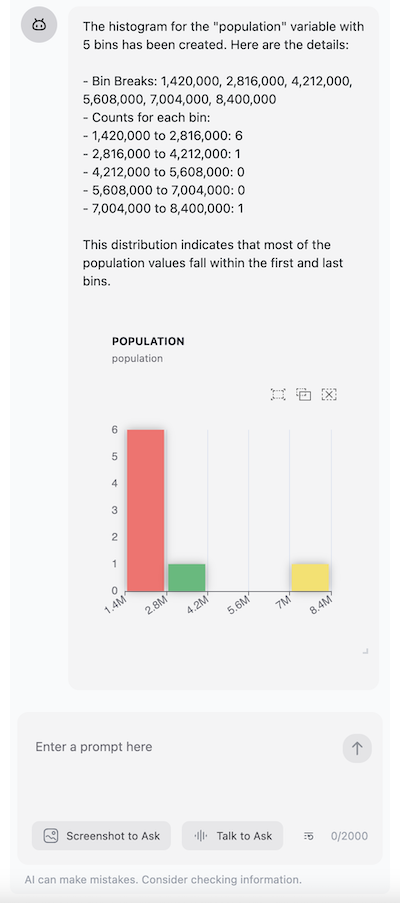@openassistant/plots
The plot tools for OpenAssistant provides powerful visualization capabilities using Vega-Lite and Apache ECharts.

Features
| Tool Name | Description |
|---|---|
| vegaLitePlot | create a Vega-Lite plot, e.g. bar chart, line chart, scatter plot, etc. from a dataset. The vega-lite plots are listed here. |
| Interactive Plots | create a eCharts plot that can be interactive with other components e.g. map, table, etc. |
| histogram | create a histogram plot from a dataset |
| scatterplot | create a scatter plot from a dataset |
| parallelCoordinates | create a parallel coordinates plot from a dataset |
| boxplot | create a box plot from a dataset |
| bubblechart | create a bubble chart from a dataset |
Installation
npm install @openassistant/plots @openassistant/utils ai
Quick Start
Suppose you have a dataset which could be fetched from your data API. The json data could look like this:
const SAMPLE_DATASETS = {
myVenues: [
{ "location": "New York", "latitude": 40.7128, "longitude": -74.0060, "revenue": 12500000, "population": 8400000 },
...
]
};
Share the meta data of your dataset in the system prompt, so the LLM can understand which datasets are available to use when creating a plot.
The meta data is good enough for the AI assistant. Don't put the entire dataset in the context, and there is no need to share your dataset with the LLM models. This also helps to keep your dataset private.
const systemPrompt = `You can help users to create a map from a dataset.
Please always confirm the function calling and its arguments with the user.
Here is the dataset are available for function calling:
DatasetName: myVenues
Fields: location, longitude, latitude, revenue, population`;
You can use the vegaLitePlot tool to create a Vega-Lite plot from a dataset.
import { vegaLitePlot, VegaLitePlotTool } from '@openassistant/plots';
import { convertToVercelAiTool } from '@openassistant/utils';
import { generateText } from 'ai';
const vegaLitePlotTool: VegaLitePlotTool = {
...vegaLitePlot,
context: {
getValues: async (datasetName, variableName) => {
// get the values of the variable from dataset, e.g.
return SAMPLE_DATASETS[datasetName].map((item) => item[variableName]);
},
},
onToolCompleted: (toolCallId, additionalData) => {
console.log('Tool call completed:', toolCallId, additionalData);
// you can import { VegaPlotComponent } from '@openassistant/vegalite';
// render the Vega plot using <VegaPlotComponent props={additionalData} />
},
};
generateText({
model: openai('gpt-4o-mini', { apiKey: key }),
system: systemPrompt,
prompt:
'Can you create a bar chart of the population for each location in dataset myVenues?',
tools: {
vegaLitePlot: convertToVercelAiTool(vegaLitePlotTool),
},
});
Interactive Plots Example
Here is an example of using AiAssistant to create eCharts plots that can be interactive with other components e.g. map, table, etc.
Install the dependencies:
npm install @openassistant/plots @openassistant/ui @openassistant/echarts
Then, you can use the AiAssistant component to create the plots.
import {
histogram,
HistogramTool,
scatterplot,
ScatterplotTool,
} from '@openassistant/plots';
import {
HistogramComponent,
ScatterplotComponent,
} from '@openassistant/echarts';
import { AiAssistant } from '@openassistant/ui';
const histogramTool: HistogramTool = {
...histogram,
context: {
getValues: (datasetName, variableName) => {
return SAMPLE_DATASETS[datasetName][variableName];
},
onSelected: (datasetName, selectedIndices) => {
// you can use the selected indices to sync the selection in other components e.g. table, map, etc.
console.log('Selected indices:', selectedIndices);
},
},
component: HistogramComponent,
};
const scatterplotTool: ScatterplotTool = {
...scatterplot,
context: {
getValues: (datasetName, variableName) => {
return SAMPLE_DATASETS[datasetName][variableName];
},
onSelected: (datasetName, selectedIndices) => {
// you can use the selected indices to sync the selection in other components e.g. table, map, etc.
console.log('Selected indices:', selectedIndices);
},
},
component: ScatterplotComponent,
};
// use the tool in the chat component
<AiAssistant
modelProvider="openai"
model="gpt-4o"
apiKey={process.env.OPENAI_API_KEY || ''}
welcomeMessage="Hello! How can I help you today?"
system={systemPrompt}
functions={{ histogram: histogramTool, scatterplot: scatterplotTool }}
/>;
Once set up, you can create histograms through natural language prompts:
- For histograms: "Create a histogram of the 'revenue' variable"
- For scatter plots: "Show me a scatter plot of revenue vs population"
The assistant will automatically understand your request and use the appropriate visualization function.
See the example for more details.
With TailwindCSS
If you are using TailwindCSS, make sure to include the package's CSS in your project:
import { heroui } from '@hero-ui/react';
/** @type {import('tailwindcss').Config} */
module.exports = {
content: [
'./src/**/*.{js,ts,jsx,tsx}',
'./node_modules/@heroui/theme/dist/**/*.{js,ts,jsx,tsx}',
'./node_modules/@openassistant/echarts/dist/**/*.{js,ts,jsx,tsx}',
],
theme: {
extend: {},
},
darkMode: 'class',
plugins: [heroui()],
};